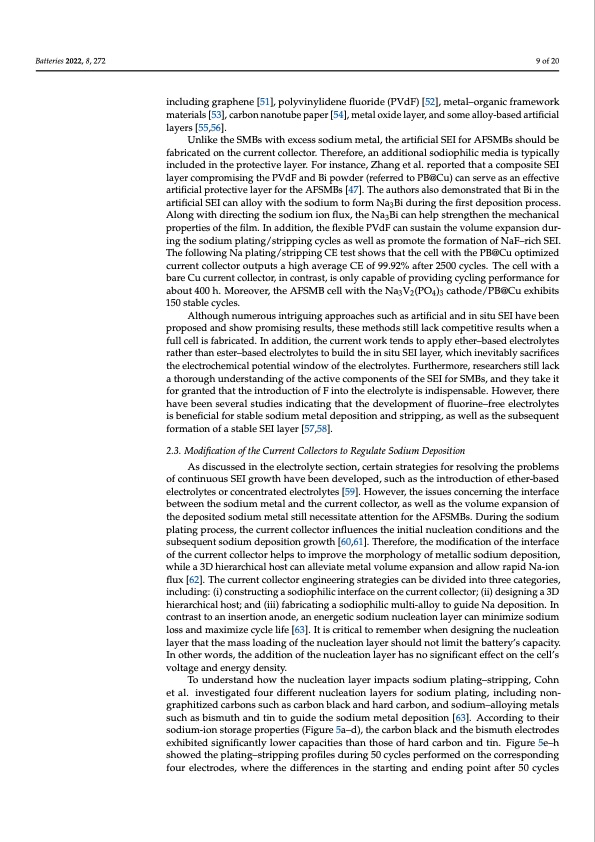
PDF Publication Title:
Text from PDF Page: 009
Batteries 2022, 8, 272 9 of 20 including graphene [51], polyvinylidene fluoride (PVdF) [52], metal–organic framework materials [53], carbon nanotube paper [54], metal oxide layer, and some alloy-based artificial layers [55,56]. Unlike the SMBs with excess sodium metal, the artificial SEI for AFSMBs should be fabricated on the current collector. Therefore, an additional sodiophilic media is typically included in the protective layer. For instance, Zhang et al. reported that a composite SEI layer compromising the PVdF and Bi powder (referred to PB@Cu) can serve as an effective artificial protective layer for the AFSMBs [47]. The authors also demonstrated that Bi in the artificial SEI can alloy with the sodium to form Na3Bi during the first deposition process. Along with directing the sodium ion flux, the Na3Bi can help strengthen the mechanical properties of the film. In addition, the flexible PVdF can sustain the volume expansion dur- ing the sodium plating/stripping cycles as well as promote the formation of NaF–rich SEI. The following Na plating/stripping CE test shows that the cell with the PB@Cu optimized current collector outputs a high average CE of 99.92% after 2500 cycles. The cell with a bare Cu current collector, in contrast, is only capable of providing cycling performance for about 400 h. Moreover, the AFSMB cell with the Na3V2(PO4)3 cathode/PB@Cu exhibits 150 stable cycles. Although numerous intriguing approaches such as artificial and in situ SEI have been proposed and show promising results, these methods still lack competitive results when a full cell is fabricated. In addition, the current work tends to apply ether–based electrolytes rather than ester–based electrolytes to build the in situ SEI layer, which inevitably sacrifices the electrochemical potential window of the electrolytes. Furthermore, researchers still lack a thorough understanding of the active components of the SEI for SMBs, and they take it for granted that the introduction of F into the electrolyte is indispensable. However, there have been several studies indicating that the development of fluorine–free electrolytes is beneficial for stable sodium metal deposition and stripping, as well as the subsequent formation of a stable SEI layer [57,58]. 2.3. Modification of the Current Collectors to Regulate Sodium Deposition As discussed in the electrolyte section, certain strategies for resolving the problems of continuous SEI growth have been developed, such as the introduction of ether-based electrolytes or concentrated electrolytes [59]. However, the issues concerning the interface between the sodium metal and the current collector, as well as the volume expansion of the deposited sodium metal still necessitate attention for the AFSMBs. During the sodium plating process, the current collector influences the initial nucleation conditions and the subsequent sodium deposition growth [60,61]. Therefore, the modification of the interface of the current collector helps to improve the morphology of metallic sodium deposition, while a 3D hierarchical host can alleviate metal volume expansion and allow rapid Na-ion flux [62]. The current collector engineering strategies can be divided into three categories, including: (i) constructing a sodiophilic interface on the current collector; (ii) designing a 3D hierarchical host; and (iii) fabricating a sodiophilic multi-alloy to guide Na deposition. In contrast to an insertion anode, an energetic sodium nucleation layer can minimize sodium loss and maximize cycle life [63]. It is critical to remember when designing the nucleation layer that the mass loading of the nucleation layer should not limit the battery’s capacity. In other words, the addition of the nucleation layer has no significant effect on the cell’s voltage and energy density. To understand how the nucleation layer impacts sodium plating–stripping, Cohn et al. investigated four different nucleation layers for sodium plating, including non- graphitized carbons such as carbon black and hard carbon, and sodium–alloying metals such as bismuth and tin to guide the sodium metal deposition [63]. According to their sodium-ion storage properties (Figure 5a–d), the carbon black and the bismuth electrodes exhibited significantly lower capacities than those of hard carbon and tin. Figure 5e–h showed the plating–stripping profiles during 50 cycles performed on the corresponding four electrodes, where the differences in the starting and ending point after 50 cyclesPDF Image | Anode-Free Rechargeable Sodium-Metal Batteries

PDF Search Title:
Anode-Free Rechargeable Sodium-Metal BatteriesOriginal File Name Searched:
batteries-08-00272.pdfDIY PDF Search: Google It | Yahoo | Bing
Salgenx Redox Flow Battery Technology: Salt water flow battery technology with low cost and great energy density that can be used for power storage and thermal storage. Let us de-risk your production using our license. Our aqueous flow battery is less cost than Tesla Megapack and available faster. Redox flow battery. No membrane needed like with Vanadium, or Bromine. Salgenx flow battery
| CONTACT TEL: 608-238-6001 Email: greg@salgenx.com | RSS | AMP |